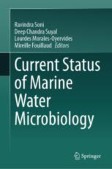Search
Search Results
-
Microfossils as Proxies: Paleoecological and Paleoceanographic Indicators
Proxies are useful tools in paleoceanographic and paleoecological reconstructions. Biological proxies are represented by several groups of...
-
Survival in a Sea of Gradients: Bacterial and Archaeal Foraging in a Heterogeneous Ocean
Marine microbial ecology is usually investigated over large spatial and temporal scales, under the assumption that planktonic organisms and solutes...
-
Physical contact stress can trigger larval release in the brooding coral Siderastrea stellata
Abiotic and biotic stressors are known to trigger reproductive activities in several aquatic organisms. In reef environments, physical contact as a...

-
Eukaryotic plankton communities across reef environments in Bocas del Toro Archipelago, Panamá
Variation in light and temperature can influence the genetic diversity and structure of marine plankton communities. While open-ocean plankton...

-
Management of Nearshore Hardbottom Reef Resources
The primary anthropogenic impacts to shallow nearshore reefs of east Florida occur from their burial by large quantities of sediments (fill) that are...
-
Variable responses to chronic and acute elevated temperature of three coral species from reefs with distinct thermal regimes
Ocean warming and marine heatwaves caused by climate change are adversely affecting the health, structure, and function of coral reefs globally. As...

-
Vibrio tetraodonis subsp. pristinus subsp. nov., isolated from the coral Acropora cytherea at Palmyra Atoll, and creation and emended description of Vibrio tetraodonis subsp. tetraodonis subsp. nov
Strain OCN044 T was isolated from the homogenised tissue and mucus of an apparently healthy Acropora cytherea coral fragment collected from the...

-
Phylogenomic analysis of the Ponticus clade: strains isolated from the spotted rose snapper (Lutjanus guttatus)
The family Vibrionaceae is classified into many clades based on their phylogenetic relationships. The Ponticus clade is one of its clades and...

-
Environmental DNA for Biodiversity Monitoring of Coral Reefs
Coral reefs are globally significant repositories of marine biodiversity. Over 25% of all marine life depends on coral reefs at some point in their...
-
Advances in Coral Biology
Understanding coral biology is crucial for coral reef management under the crisis of global change. This chapter provides updated knowledge on...
-
Algae from Primary Endosymbioses
TheRhodophyta red algaeRed algae are a group of important photoautotrophic organisms that include unicellular microalgae as well as large macroalgae...
-
Solar UV-B and Primary Producers in Aquatic Ecosystems
Primary producers in aquatic ecosystems are bound to dwell in the photic zone since exposure to solar visible radiation is a requirement for energy...
-
Reproductive biology and early life history of the solitary coral Heliofungia actiniformis from Singapore and the Philippines
Reproduction and early life history are central to understanding the biology and ecology of organisms, however such information is limited for...

-
Monitoring marine fishes using underwater video techniques in the Mediterranean Sea
The use of underwater video techniques has expanded rapidly in ecological studies and is particularly desirable in protected areas since the method...

-
Effects of material type and surface roughness of settlement tiles on macroalgal colonisation and early coral recruitment success
Sexual propagation of corals is a promising strategy for coral restoration, but one of the main challenges is the high mortality of coral spat due to...

-
Intertidal mussel reefs change the composition and size distribution of diatoms in the biofilm
Migrating diatoms are microscopic ecosystem engineering organisms that have functional consequences on the seascape scale by significantly...

-
Current Status of Seaweed Diversity: Anthropogenic Interventions
Seaweeds are an essential primary producers and are considered the most important life forms in the coastal ecology. They shelter marine and other...
-
Coral fluorescence: a prey-lure in deep habitats
Fluorescence is highly prevalent in reef-building corals, nevertheless its biological role is still under ongoing debate. This feature of corals was...

-
The giant clam Tridacna squamosa quickly regenerates iridocytes and restores symbiont quantity and phototrophic potential to above-control levels in the outer mantle after darkness-induced bleaching
Giant clams are ecologically and economically relevant reef inhabitants that host photosynthetic dinoflagellates inside tubules located mainly in...

-
Cyanobacteria in Ocean
An important turning point in the Earth’s surface’s geochemical history may be seen with the appearance of cyanobacteria, which were widespread...
